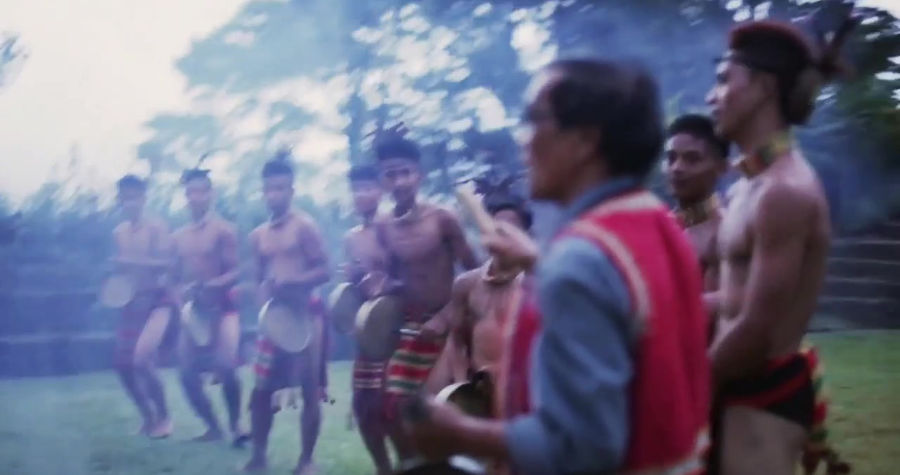

As a young boy in Lubuagan, Kalinga, Alonzo Saclag was enthralled by the sights and sounds of everyday village life and ritual. According to his son, he received neither formal or informal training in the performing arts. Despite this, he has learned not only Kalinga musical instruments, but also dancing patterns and moves linked with his people's traditions. His instrument was observation, and his teacher was experience. Along with these, he had a strong interest - a love, if you will - in the culture that had been passed down to him.
On August 4, 1942, Alonzo Saclag was born. Saclag, a Kalinga native from Lubuagan in Kalinga province, taught himself about his people's performing arts traditions. Without formal or informal instruction, he learned to play traditional Kalinga musical instruments and perform Kalinga ritual dance moves.

Saclag attempted to bring back the dying tradition of gangsa, a form of Kalinga gong. Saclag petitioned the provincial government for two years to award funds to transform the abandoned Capitol Building into a museum. A branch of the National Museum was constructed in Lubuagan with the help of the province government and other financiers.
Saclag also advocated for the promotion of Kalinga culture in his community's schools by meeting with school administrators. He was a driving force behind the habit of pupils wearing traditional Kalinga dress to key school events, as well as the teaching of Kalinga folk melodies in schools. He also advocated for traditional Kalinga music to be broadcast alongside contemporary music on their local radio station. He also founded the Kalinga Budong Dance Troupe to bring Kalinga dance to a wider audience.
FLUTES

BAMBOO FLUTES
Bamboo flutes are generally end-blown flutes, with the air stream directed into the open top end of the Bamboo and have three to four holes in the middle that form the gapped scales. Some flutes have incised geometric designs that are formed by burning the bamboo surface with a sharp knife to show the black lines against the natural yellowish skin of the dry bamboo.


Paldong of the Kalinga is a traditional lip-valley notch flute. The open mouthpiece of this flute is bent at a slant to follow the contour of the player's lower lip. A notch is cut at the opposite end of the flute to designate the end of the instrument. It is most commonly used for self-entertainment and courtship. The lip-valley notch flute's tune mimics the sounds of chirping birds, eagle cries, and wasp buzzes.




PALDONG

TONGALI
Tongali of the Kalinga tribe is a nasal flutes, on the other hand, have a node on one end and an open end. The nose flute's closed end features a tiny hole in the middle for blowing. The player shuts one nostril and forces air into the little opening via the other. Nose flutes are usually played by men and are used for courting or leisure at night, whereas the Kalinga tonggali is played during wakes and funerals.





Dance
PERCUSSIONS


Bungkaka of the Kalinga tribe, or bamboo buzzer, is an idiophone, or percussion instrument that creates sounds when vibrating. It is made from a buho ( bamboo) with two tongue-like shapes at the upper half facing each other that produces the sound, and a node at the bottom end.
BUNGKAKA




GANGSA
Gangsa is another Instrument that Saclag mastered. It is a single hand-held smooth-surfaced gong with a narrow rim. Gangsa can also be played in ensembles by a group of musicians, with one gong with a unique tune per musician to create variety of sounds. It can be played in two ways, Toppaya and Pattung. Toppaya style suspends a gangsa from the left hand and struck with a paddle stick on the right hand. In Pattung style, the players are standing bending forward, or dancing in sync with the dancers.
Manlilikha ng Bayan Alonzo Saclag, a performing arts master from Lubuagan, Kalinga, is a specialist in playing tonggali and other ritual-related Kalinga musical instruments.
TRADITIONAL CLOTHING


A set of Kalinga male traditional wear, including a vest, baag (g-string), dallisdis we ballong (necklace or choker), lawi / uskong (headdress with feather plume), and kalugung or cattagang (cap), formerly owned and worn by Manlilikha ng Bayan Alonzo Saclag, was donated to the National Museum of the Philippines in 2015 by the National Commission for Culture and the Arts' Gawad s These are now on display in the National Museum of Anthropology's 3F's refurbished Manlilikha ng Bayan Hall.
AWICHON VILLAGE




Alonzo Saclag, one of NCCA's National Living Treasures, owns and develops Awichon Cultural Village. The community is located on a hilltop in Barangay Dangoy, 7 kilometers from the town core, between Pasil and Lubuagan. The NCAA designated it as the Kalinga Center for Culture and Arts in May 2008. During World War II, the location was used as a landing zone for American soldiers.


All Videos
Alonzo Saclag is also known as a master of dance and performing arts with a mastery of traditional dance patterns and movements for entertainment or ritual dances. He founded the Kalinga Budong Dance Troupe to revive and transmit their music and dances, as well as the wearing of traditional clothes and adornments.
References:
https://www.facebook.com/Alonzo-Saclag-760463250695242/
https://www.facebook.com/Alonzo-Saclag-760463250695242/photos/1194447973963432
https://www.facebook.com/194149337276059/posts/3446278908729736/?sfnsn=mo&mibextid=AJcxSj
https://www.pinterest.ph/pin/288652657353116446/
https://www.flickr.com/photos/govph/15766907793/in/photostream/
https://philippines.travel/activities/awichon-cultural-village
https://pinoy-culture.tumblr.com/post/25454277347/gangsa-traditional-musical-instruments-from-the
https://www.youtube.com/watch?v=zlZciQqNLgo&ab_channel=ClintonSuyao
https://www.facebook.com/NCCAOfficial/videos/1823688407748856
https://www.youtube.com/watch?v=PL4H4o568X0&t=32s (Watch this video on Alonzo Saclag (15:22-20:56)
MEMBERS
Gwen Dalumpines
Denise Javier
Chynna Lei Reyes
Angelica Ohdo





